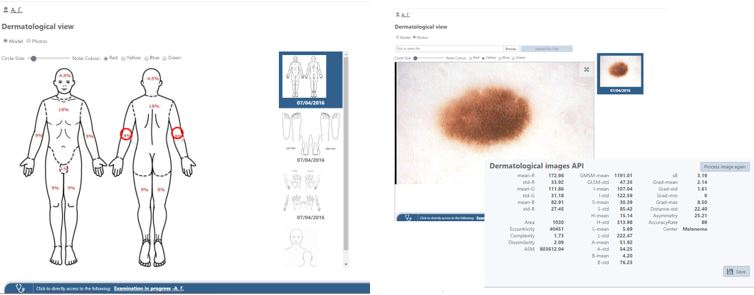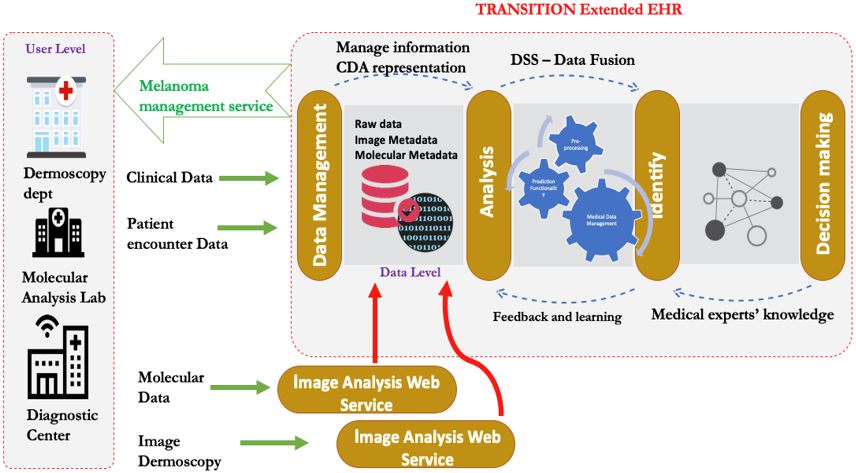Ilias Maglogiannis
Professor
The study is based on multimodal analysis of demographic, clinical, imaging and molecular data
Image Dermoscopy data are utilized for the systematic monitoring of changes in skin lesions and the early diagnosis of Cutaneous Melanoma (CM).
An integrated Electronic Health Record SW is designed and developed, especially for the epidemiological management of a disease.
The Computational Biomedicine Laboratory (http://cbml.ds.unipi.gr/en/) in University of Piraeus implements in collaboration with other partners[1] the R&D project TRANSITION, aiming at the multilevel study of Cutaneous Melanoma (CM) through the intelligent combinatorial analysis of clinical, imaging and molecular data of patients with CM.
Cutaneous Melanoma with Deep Learning Techniques
CM is a malignant tumor of the skin’s melanocytes, the cells that are located in the basal layer of the epidermis and produce the pigment called melanin. Although CM accounts for less than 5% of skin cancer cases, it is responsible for the majority of deaths associated with it, due to its extremely aggressive nature. In recent decades, the frequency of CM incidents has been steadily increasing worldwide, due to aspects of the modern, western lifestyle (tourism and increased intermittent sun exposure, diet) and it is predicted that the increase will continue.
In the case of melanoma, the need for early diagnosis, much more intense than most types of cancer, becomes even more important because if the melanoma is detected early it can be successfully operated and cured completely. Otherwise, despite recent positive developments in the treatment of metastatic melanoma with targeted drugs and immunotherapy, the prognosis of melanoma at an advanced stage is particularly grim and the costs extremely high.
The project is extremely innovative from a technological point of view because:
- A multilevel molecular characterization of patients with melanoma is performed for the first time in Greece. More specifically, definition of potential inherited polymorphisms that may be associated with predisposition to the disease, detection of body mutations (mutations specific to cancer tissue) of each patient and study of the selected target genes’ expression of in cancer tissue will be performed.
- Dermoscopy and confocal microscopy data are utilized for the systematic monitoring of changes in skin lesions and the early diagnosis of CM. More specifically, the correlation of the extracted visual characteristics with the molecular data will help in the designation of complex signatures for the diagnosis of CM and the understanding of the disease’s mechanisms. On the other hand, it will provide the basis for the extraction of new, improved and non-invasive disease classifiers through the utilization of new pattern recognition and deep machine learning techniques (Deep Neural Networks).
- An Integrated Electronic Health Record software is designed and developed, treating the CM as a realistic complexity model for the epidemiological management of a disease, completing all the individual subsystems and facilitating the processes of rational planning and medical decision-making support.
Although the software for the processing of dermoscopic images, developed by the research team in the Computational Biomedicine Laboratory, can work as a standalone application, it follows the principles of distributed computing and it is available as a programming interface (Application Programming Interface – API) to be integrated in the information system that is developed by the project. Its functionality is provided through Internet services (REST Web Services). REST (Representational State Transfer) provides a flexible architecture, allowing the exchange of different message formats for the communication between different information systems. Examples of these applications can be found at http://cbml.ds.unipi.gr/en/demos/
[1] The Transition project “Translating the diagnostic complexity of melanoma into rational therapeutic stratification” is co‐financed by the European Union and Greek national funds through the Operational Program Competitiveness, Entrepreneurship and Innovation, under the call RESEARCH – CREATE – INNOVATE. Datamed Systems Integration SA, the National Hellenic Research Foundation and the University Clinic of Cutaneous and Venereal Diseases at ANDREAS SYGGROS HOSPITAL participate in the project together with the University of Piraeus.




